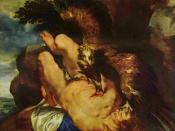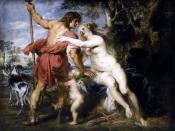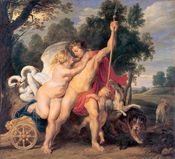-Was only marked down for using internet sources because the instructor preferred text.
Flemish artist, Peter Paul Rubens (1577-1640) was the most prolific painter of the seventeenth century. Working in the Baroque style, he created an insurmountable number of works, over two thousand (Strickland, 1992, p. 50). To this day, his works have had a substantial impact on the course of art history, influencing such artists as Eugene Delacroix and Jean-Honore Fragonard (Loadstone, 2005). Creating works with subjects ranging from religious, to mythological, to secular, et cetera, Rubens proved himself multifaceted. Although all of Rubens' works reflect his familiar style, Venus and Adonis (Figure 1) brings his most distinguishable characteristics into one harmonious composition.
Rubens was born in Siegen, Westphalia, after his Protestant father fled Antwerp as a means of escaping religious persecution. The Counter Reformation, an attempt to reaffirm Catholic doctrine after being "corrupted" and dominated by Protestant teachings, spawned this religious persecution.
Ironically, two years after his father's death in 1587, Rubens and his mother returned to Antwerp where Rubens had himself baptized a Catholic. His newfound faith played a significant role in his later works, which emanate a strong, Catholic influence (Wikipedia, 2006).
It was in Antwerp where Rubens received his foundation for the education that would eventually manufactured his artistic genius, working under such noted painters as Adam van Noort and Otto Venius. In 1600, Rubens went to Italy, where he studied classic Roman art and enhanced his skills by copying the works of the Italian masters. One such master that had the most momentous influence on Rubens' later works was Titian (Wikipedia, 2006).
Despite his Northern European heritage, Rubens worked for rulers throughout all of Europe, including, Italy, France, Spain and England. Although important commissioners throughout all of Europe were familiar with and sought after...


